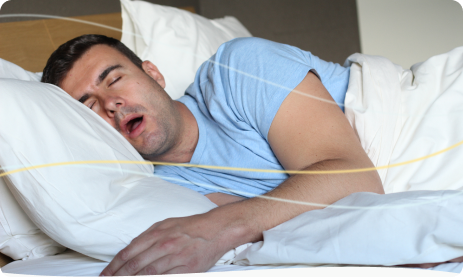Obstructive Sleep Apnea / Snoring
Obstructive sleep apnea is a common sleep disorder that involves repeated breathing interruptions during sleep. These interruptions may occur hundred of times each night, and may be the result of structural abnormalities or brain malfunctions. During normal breathing, air passes through the nose, past the flexible structures in the back of the throat, including the soft palate, uvula and tongue. When a person is awake, the muscles hold this airway open. When they are asleep, these muscles relax and the airway usually stays open. Sleep apnea occurs when the upper airway and airflow are blocked, causing the oxygen levels to drop both in the brain and the blood, resulting in shallow breathing or breathing pauses during sleep.
Sleep apnea may be treated with lifestyle changes such as losing weight, cutting down on alcohol consumption and quitting smoking. Nasal training devices are also commonly used to treat sleep apnea. Other treatment for sleep apnea may include continuous positive airway pressure, or CPAP, which involves the patient wearing a pressurized mask over their nose while they sleep. The mask pumps air through the airway to keep it open.
If conservative treatment is unsuccessful in treating sleep apnea, there are other options available. Individuals who suffer from severe cases of sleep apnea that may lead to serious medical conditions, may benefit from surgery. The goal of most surgical procedures is to remove the excess tissue from the nose or throat and open upper air passages to facilitate breathing.
Inspire Sleep Therapy
An Alternative to CPAP
Inspire®️ Upper Airway Stimulation (UAS) is the only FDA-approved implantable treatment for people with Obstructive Sleep Apnea (OSA). You may be a good candidate for Inspire Therapy if you have moderate-to-severe OSA and are unable to use or get consistent benefit from Continuous Positive Airway Pressure (CPAP). Our physicians will evaluate your overall health status and perform a physical examination of your airway to determine if Inspire therapy might be a suitable CPAP alternative for you.
Read MoreUvulopalatopharyngoplasty (UPPP)
Uvulopalatopharyngoplasty, or UPPP, is a surgical procedure that treats sleep apnea by removing excess tissue in the throat and, as a result, widening the airway. This allows air to move through the throat more easily when patient’s breathe, effectively reducing the symptoms of snoring and sleep apnea.
- Excess tissue in the nose, mouth or throat that blocks the airways and causes breathing abnormalities
- Those for whom lifestyle changes and conservative treatments have failed
- Those who are unable to tolerate the CPAP, or Continuous Positive Airway Pressure treatment
In addition to widening the airway, UPPP also aims to improve the movement of the soft palate and help the airway remain open during sleep.
In-Office Procedures
Septoplasty
Septoplasty is a surgical procedure to correct defects or deformities of the septum, the partition between the two nostrils. Commonly, the procedure is performed to correct a deviated septum. While a small deviation of the septum is commonplace, if the condition is severe, it may impede airflow through the nostrils. This may cause difficulty breathing and poor nasal drainage from the sinuses, both of which are problematic.
In adults, the nasal septum is composed of both cartilage and bone. The function of the nasal septum is to support the mucous membranes of the nose and to regulate air flow. Septoplasty is commonly performed to help relieve nasal obstruction and in some cases it may be a part of other surgical procedures including sinus surgery or nasal tumor or polyp removal. Septoplasty straightens the nasal septum by trimming, repositioning and replacing cartilage or bone within the nose.
Turbinate Reduction
Turbinate reduction is a surgical procedure to reduce the size of one or more of the small curved bones in the nose, known as turbinates, in order to open clogged nasal passages and improve breathing. There are three pairs of turbinates in the nose, classified as inferior, middle and superior. Their function is to warm, filter and humidify air as it circulates through the nose and into the lungs. Since they serve as filters, the turbinates help to protect the body from irritants and stave off infection.
Turbinate reduction is performed when a patient’s turbinate is abnormally large, creating a nasal obstruction. The turbinates may swell in response to ear, nose and throat allergies or upper respiratory infections, resulting in a number of troubling symptoms which may include chronic nasal congestion, recurrent sinusitis, frequent nosebleeds and difficulty sleeping. If traditional treatments, such as nasal decongestants, antihistamines, allergy shots and antibiotics do not resolve these problems, surgical intervention is usually recommended.
Turbinate reduction may be performed using a few different surgical methods, depending on the patient’s overall medical condition and the nature of the problem. The procedure is frequently performed in conjunction with corrective surgery for a deviated septum, known as a septectomy. Turbinate reduction is performed as an outpatient procedure and the patient should expect to resume a limited normal routine in approximately a week. While turbinate reduction operations are considered quite safe, there is always some risk involved in any surgical procedure.
Home Sleep Study
Although many sleep studies are performed in testing facilities, we offer a home sleep study that can be used in a patient’s home. During the sleep study, a small recording device is attached to the patient over two nights. Your physician will then get your sleep study results from a Board Certified Sleep Specialist.



